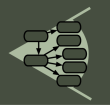





|
|


|
|
||
 |
|
|
Session 1: Observational data "in the wild"
Breakout-Group Products
BackgroundIt is likely that workshop participants will have different perspectives on what constitutes observational data. This session will consider the various definitions in use for the terms 'observation' and 'observational data' to ascertain the breadth of the concepts that need to be captured/represented in a formal model. The objective is to clarify the various issues and underlying assumptions surrounding these terms, while forming a working consensus definition for 'observation' that will be used throughout the workshop.
Discussion TopicsWhat is meant by 'observation' and 'observational data'? What are the different types of observational data that should be considered in a standard data model? Possible issues:
Session notes and resultsSOME MORE SPECIFIC ISSUES TO DISCUSS 1) Can (or should) we derive a core set of terms that completely enable the generic description of "scientific observations"? General enough to enable description of any type of scientific observation (how does "scientific" constrain our definition of an observation, if at all?) Should we scope observation to only pertain to some specific types of interests? Is there a mechanism for specializing/refining descriptions of observation to make "the framework" useful for data integration? Are there ways to "add" domain-specific extension to the core definition of an "observation"?
2) Can we establish synonymies and other mappings among terms in the various Observation Models presented so far? And aside from synonymies, also clarify subsumption (more/less general) and other (part_of, constituted_of) relationships among terms in the various models? Can we identify necessary "components" of the various models for observation (e.g., are space and time information explicitly necessary?); necessary & sufficient (is it sufficient to simply have some measured value of some property of an entity? 3) Need unambiguous definitions of Keywords* (currently massive overloading on many of those listed below...) Observation Entities concrete/theoretical; thing'ish vs process'ish Attributes/characteristics/features/traits Procedure/method Instrument Measurement Units Measurement standards Specimen/record/collection Time/duration Location--point, others Context/composition/complex types Transformations/identity Essential (necessary) features or components 4) Is modeling the assertion of some specific ("named") entity type (e.g., rock, crow) best considered as a special form of measurement (attribute type=NAME) Identifying vs non-identifying names (e.g., Corvus corax vs "Plot A") presence/absence measurements-- do these need to be treated (ontologically) different from say, measuring mass of a specimen? names-- are names a special characteristic associated with an entity (a "name" is classifying the entity as some thing) counts (is a property of set of individuals)-- how does observation model accomodate this type of measurement?
5) Do "where" and "when" information pertain globally and consistently to any type of observation of interest, or are these also types of observations that can provide context for other observations? 6) Is there ability within the Observation model, to inter-relate observations to "construct" composite and emergent entities, processes or phenomena? 7) How can ontology/model be deployed in terms of real useful applications? Must data be ingested into a framework implementing the model, or can the model(s) be applied to data (e.g., via annotation) 8) Is there possibility for multiple interpretations of a given observation? Is this ever necessary or desirable? 9) How indicate that parts of tuple are dependent/independent e.g. enriching context can be optional, but high dependency requires association of two observations ( 10) How rich must be set of associations/relations among observations. How specialized can these get? (wolf fighting mountain lion) 11) Is it important to be able to differentiate individual instances vs. generic assertions in a data set ("a wolf fighting a mountain lion" vs "wolves fight mountain lions")
|
| This material is based upon work supported by the National Science Foundation under award 0619060. Any opinions, findings and conclusions or recomendations expressed in this material are those of the author(s) and do not necessarily reflect the views of the National Science Foundation (NSF). Copyright 2007 |